By Rich Moniak
In December 2012, then-Gov. Sean Parnell announced the state was dropping plans to build a new 350-foot Alaska Class Ferry. Instead, he ordered design work to begin on two smaller, less expensive ferries. As anyone familiar with this story knows, when the Tazlina and Hubbard rolled out of the shipyard, they weren’t capable of functioning on their intended Lynn Canal routes.
The lack of transparency is largely to blame for those design errors. Now, Gov. Mike Dunleavy seems to be heading in the same direction with possible plans for a ferry terminal at Cascade Point.
Let’s start with Parnell’s hidden agenda. For anyone outside his trusted circle, the ferry switch was a total surprise.
“We’re all upset that we weren’t informed way early in this process” Juneau Sen. Dennis Egan said immediately after Parnell’s announcement. “We didn’t have a clue.”
According to the news reporter at CoastAlaska, Robert Venables, chairman of the Marine Transportation Advisory Board, indicated that the board wasn’t even given a hint about the changes.
If they didn’t know anything about it, then it goes without saying that Parnell never sought public input.
The proposed redesign didn’t include the forward side doors needed to load and offload vehicles at the existing terminals in Haines and Skagway. Nor the crew quarters that would allow the ships to make the 12 hour plus roundtrip between Juneau to Skagway.
The earliest concepts had other clues that they weren’t intended to sail the full length of Lynn Canal. Like the fast ferries that cut the sailing time in half, it was proposed these wouldn’t be equipped with a cafeteria. One preliminary drawing even showed the rear of the car deck would be left uncovered.
That’s fine for ferries sailing short distances such as those that connect communities on Puget Sound. It would make sense to design the Hubbard and Tazlina that way only if they were intended for a similar purpose. Such as shuttling travelers between Haines and Skagway and a new ferry terminal at Katzehin. And we know from the Draft Supplemental Environmental Impact for the Juneau Access project that’s exactly how Parnell was planning to use both ferries.
The state was in the process of drafting the SEIS when the ferry redesign decision was made. But it wasn’t finished until early 2014. In the interim, Parnell never hinted that they’d be used as shuttles from Katzehin. Had he done so, everyone would have recognized he was putting the cart before the horse. The Lgislature could have put the ferry redesign on hold until after the public had weighed in on the SEIS.
Instead, they were built without the forward side doors and crew quarters. The state spent $4.4 million to add the doors. The price tag to add crew quarters on one is estimated at $15 million. Dunleavy is focused on avoiding that cost by shortening the sailing time with a new ferry terminal at Cascade Point.
As I wrote more than two years ago, a conceptual design by overseen by the Design Group Chief for the Southeast Region identified all the reasons why a terminal 29 miles farther from town is a bad idea. Among them is the lack of electrical power; potable water and sewage facilities; exposure to extreme winter winds; and an estimated $16 million in necessary road improvements just to get there.
The obvious irony is those problems wouldn’t need to be solved if Parnell had been entirely transparent.
That appears to be lost on Dunleavy. His administration is negotiating with Goldbelt to build the new terminal at Cascade Point. Among the important people he’s keeping out of the loop is John Falvey, General Manager for the Alaska Marine Highway System.
Parnell wanted us to think his decision was all about saving money and operational efficiency. After all, who could argue that two ferries for half the price of one would be remembered as a mistake. But his hidden agenda turned the Tazlina and Hubbard into embarrassments that undermine the public’s trust in state government.
Dunleavy promised to restore that trust right after taking office. Keeping residents of the Lynn Canal corridor in the dark won’t do it. But that fits right alongside the bigger promise he broke to maintain “a functional, robust ferry service” in Southeast Alaska.
• Rich Moniak is a Juneau resident and retired civil engineer with more than 25 years of experience working in the public sector. Columns, My Turns and Letters to the Editor represent the view of the author, not the view of the Juneau Empire. Have something to say? Here’s how to submit a My Turn or letter.

